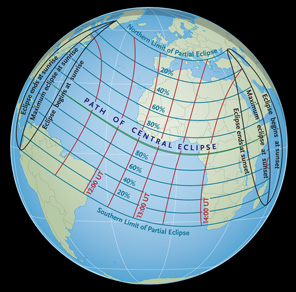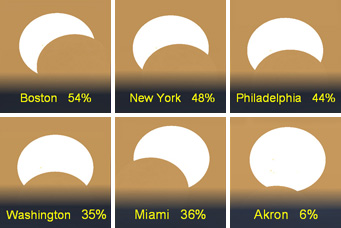Syzygially speaking, the year's big event is a "hybrid" solar eclipse. The Moon passes directly across the Sun, yielding a fleeting annular eclipse at the beginning and a relatively brief total eclipse later on.
When the Moon passes directly between the Sun and Earth, the usual outcome is either a total or annular solar eclipse. But the event on November 3rd is something of a hybrid. At the point in the North Atlantic where the Moon's umbral shadow begins its dash across Earth, about 600 miles (1,000 km) east of Jacksonville, Florida, an extremely well-placed observer would get to see a vestigial ring of Sun surrounding the Moon's silhouette for a few fleeting seconds just after sunrise.

The eclipse on November 3, 2013, begins as an annular event (far-left end of green line) but quickly becomes a total solar eclipse as the moon's umbra crosses the Atlantic Ocean and central Africa. Click on the image for a larger version.
Sky & Telescope illustration / source: F. Espenak
But after that, as it races southeastward, the shadow's footprint is also moving closer to the Moon due to Earth's curvature. So the appearance switches to and remains a total eclipse — though a relatively short one. "Greatest eclipse," offering 99½ seconds of totality, occurs about 12:46 Universal Time at a point about 200 miles (330 km) southwest of the Liberian coast.
The Moon's umbral shadow is only 29 miles wide (47 km) when it makes landfall in Gabon, where there'll be 68 seconds of totality. Then it slides east-northeastward through Congo (up to 53 seconds), Democratic Republic of the Congo (44 seconds), Uganda (19 seconds), northern Kenya (13 seconds), before ending in southern Ethiopia and westernmost Somalia (1 second at sunset).
During the previous hybrid solar eclipse, in April 2005, a stretch of totality was sandwiched between annular views at the beginning and end. This year's edition is especially rare because it begins with annularity and ends with totality. Cartographer Michael Zeiler has amassed many maps and lots of graphical information on his website.
For a little fun envisioning "what if" circumstances along the umbral path, check out Xavier Jubier's interactive eclipse map that overlays the umbral path on Google Earth.
I'll be with Sky & Telescope's eclipse expedition on the eastern shore of Lake Turkana in northwestern Kenya, where we're hoping to see 11 seconds of totality. That's not very long — no time to be fumbling with camera settings! — but we'll be rewarded with astounding views of Baily's beads and long crimson arcs of the Sun's chromosphere.
Several other small groups will be with us in Kenya, because that's where meteorologist Jay Anderson (the "high priest" of eclipse-weather forecasting) expects the best likelihood of cloud-free skies anywhere along the path of totality across Africa. And even from there it's only about a 50:50 proposition, so wish us luck!
A Moon Bite for Breakfast
Meanwhile, a wide swath of locations in the easternmost United States, northeastern South America, the Mediterranean, and virtually all of Africa get to enjoy a partial solar eclipse — weather permitting, of course.

Weather permitting, early risers along the Eastern Seaboard can see a partial solar eclipse at sunrise on November 3, 2013. Percentages show fraction of Sun's area covered by the Moon.
Sky & Telescope illustration / source: Stellarium
In the U.S., the partial eclipse is already at maximum as the Sun peeks over the southeastern horizon at dawn. The farther east and north you are along the Eastern Seaboard, up through Boston, the better the view. Basically no one west of the Appalachian Mountains gets to see this one — early risers along a line from Akron to Atlanta experience only a slight nick in the rising Sun. The graphic at right shows six representative views.
For a more complete set of cities, have a look at Zeiler's great map. Also check out this table of partial-eclipse circumstances for various cities compiled by Fred Espenak. (Note that the table uses Universal Time, so adjust for your time zone. As luck would have it, November 3rd is the day that the U.S. and Canada switch back to standard time.)
To watch the partial eclipse at dawn, you'll need a flat, true horizon and binoculars or a telescope equipped with a safe solar filter over the front. Always use a proper solar filter when looking at the bright Sun, whether during a partial eclipse or at any other time. S&T's editors have many tips for viewing the Sun safely.
 1
1









Comments
Fred Espenak
October 14, 2013 at 10:41 pm
Kelly - Nice article. The observing site I selected for the Espenak/Spears Travel Group (to be shared with your group) was chosen to maximize the duration of totality, even though it's two kilometers north of the central line - a result of the Moon's limb profile. See you at Turkana!
You must be logged in to post a comment.
You must be logged in to post a comment.